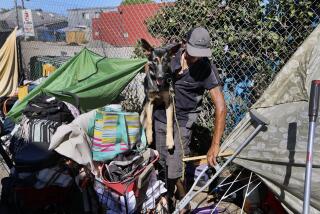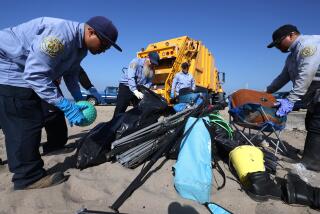Task of Moving Out the Homeless Begins : Orange County Workers Start Clearing Away Shelters Beneath Santa Ana River Bridges
- Share via
Wearing surgical masks, protective suits and rubber gloves, Orange County workers began removing piles of tattered clothes and stale bedding Monday that homeless people had fashioned into makeshift shelters beneath the Edinger Avenue bridge over the Santa Ana River.
The county’s Environmental Management Agency deployed a crew of about 20 to perform the task after nearby residents complained that those living below the roadway littered the Santa Ana neighborhood and frightened people using a bike trail that parallels the river.
For the next 2 1/2 weeks, the workers--jail inmates trading their labor for time off their sentences--will also clean beneath McFadden Avenue and 1st Street bridges. Then, all three areas will be filled with heavy rocks and cement to make the spaces uninhabitable.
As they continue to clear out the 40 or so people suspected of living beneath the bridges, officials say they will exercise compassion. Any homeless person found there will be given a list of assistance centers and 25 cents to make a telephone call, said Bill Tidwell, an EMA supervisor.
Any clothes and bedding found will be left stacked on the river banks in case a homeless person wants to claim them, Tidwell said.
“We don’t want this to be rough on anybody,” Tidwell said.
But the evictions were criticized Monday as a short-term solution to the county’s homeless problem. Scott Mather, chairman of the Orange County Homeless Task Force, said county officials should try to move the dwellers to better shelter.
“The county needs to find a more compassionate way to take care of the homeless,” Mather said. “They have no long-term solution.”
There are about 10,000 homeless people in Orange County, but only 600 shelter beds, said Susan Oakson, an administrative assistant for the Task Force. Families are given priority for the majority of the beds, and there is often no room for single adults, Oakley said.
“If they are at the overpass, it’s because they have found they have no alternatives,” Oakley said. “The overpasses keep them warmer and out of sight so they feel safer.”
Mather said the county should at least set up a temporary shelter.
“When you go to overpasses, it looks like you’ve stepped into the Third World or into another time period,” Mather said.
The areas beneath all three bridges are routinely scattered with discards and garbage, some floating on the river, some lying on the banks. The occupants beneath McFadden and 1st have tried to make their crannies more homelike by erecting temporary shelves and using candles for light. But there is broken glass where some must crawl to get to their spots. And the air is filled with the stench of human waste. Without a source of clean water, the occupants often use filthy river water to wash themselves or their clothes.
By 7 a.m. Monday, when county workers arrived at the Edinger Avenue bridge, anyone who had stayed the night had packed and moved on. Left behind were worn mattresses, some old clothing, several pairs of shoes and rusty cans.
The county inmates donned their protective gear because a hypodermic needle had been found amid the rubbish, and there was fear of encountering infection.
As the crew started the cleanup, about a dozen homeless people were just waking a mile away at the 1st Street bridge. Some splashed their faces in the muddy river. Others washed their laundry in brown pools of water. And still others were making their way out from the makeshift shelter to look for day jobs, one woman said.
A woman, who would identify herself only as Lupe, said she was 34 and had lived beneath the 1st Street bridge for two weeks. She said she doesn’t want to leave the shelter.
“This is our place. We don’t bother anybody,” she said. “Where do they want us to go?”
Three other homeless people interviewed Monday said they will probably try to stay nearby at Centennial Regional Park on Edinger Avenue at least during the day. In one parking lot at the park, there were about a dozen homeless people staying in their cars Monday.
One of them, Lucy, 30, said she had been parked on the lot with her husband and two daughters for a week and half.
“They’ll probably come here,” Lucy said of the bridge people. “Everyone shares the space,” Lucy said.
The park, however, closes between 11 p.m. to 5 a.m., and the homeless are not allowed to stay during those hours, park officials said.
More to Read
Sign up for Essential California
The most important California stories and recommendations in your inbox every morning.
You may occasionally receive promotional content from the Los Angeles Times.










